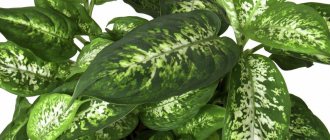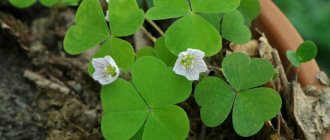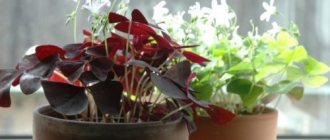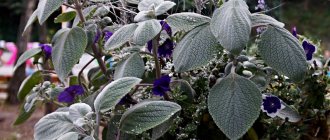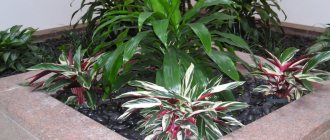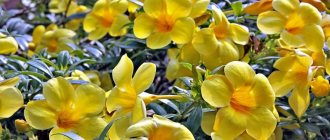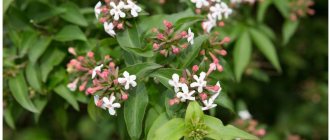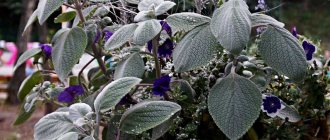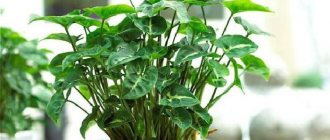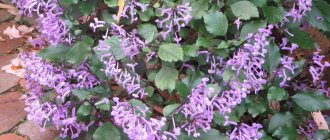The Dieffenbachia flower is an evergreen plant that came to us from America.
In total, there are about 50 species of this plant in nature.
Indoor Dieffenbachias are characterized by good adaptation to the indoor atmosphere and rapid growth . Next, we will consider what Dieffenbachia is, home care, replanting and prevention of plant diseases.
Botanical description
Dieffenbachia belongs to the Araceae family and is an evergreen plant growing in the tropical zone of South America.
Distinctive features:
- has juicy thick stems topped with large leaves of variegated colors;
- the height of an adult bush can reach 2 meters;
- flowering indoors is a rather rare occurrence, but in nature the crop blooms in April-May;
- the inflorescence is a spadix located on a green-cream blanket;
- after flowering, red or orange berries form in place of the cob;
- the culture is fast growing;
- the leaves of the plant perform a decorative function; their color is very diverse - they can be decorated with dashes, spots or stripes, depending on the variety.
The flower is named after the Australian gardener Joseph Dieffenbach at the Imperial Botanical Garden at Schönbrunn Palace in Vienna. According to folk superstitions, it is also called the “widow’s flower.” It is believed that Dieffenbachia absorbs male energy, thereby destroying family ties.
In the photo below you can see Dieffenbachia blooming, a rather rare occurrence.
Varieties and photos
The culture includes about 30-40 varieties, differing in leaf size and color. Let's look at the most popular of them. Below are photos, names and descriptions of Dieffenbachia varieties suitable for propagation and care at home:
Spotted
Dieffenbachia spotted has the following features:
- the bush is distinguished by large stems, up to 1 meter in size;
- the leaves themselves can grow up to 40 cm in length and 12 cm in width;
- leaf shape is lanceolate or oblong, slightly pointed towards the top;
- the variety attracts attention with its original spotted pattern on the leaves;
- the leaves are bright green, and the spots are multi-colored: yellow, white, emerald;
- This variety blooms with small yellow-white flowers collected in a spadix;
- At the end of flowering, red berries appear in place of the flowers.
The photo below shows Dieffenbachia Spotted:
Camilla
In nature, the Camilla variety can reach 2 meters, but in indoor conditions it is more compact. Characteristics:
- grows in the form of a bush;
- a powerful trunk is topped with lanceolate leaves, up to 40 cm long and about 15 cm wide;
- in young specimens the leaves are almost completely white, only with a green edge at the edges;
- when the bush grows, the white spot on the leaves decreases and acquires a cream or lemon tint, the edges still remain green.
Dieffenbachia Camilla does not like bright light and prefers partial shade . You can see what the Dieffenbachia Camilla variety looks like in the photo below:
Mars
This variety is distinguished by a marbled pattern on the leaves with a light vein in the center. Dieffenbachia Mars will retain its beautiful color only with sufficient light, and the crop may get burned if exposed to direct rays. The bush itself is compact, which is a definite plus for small apartments. The photo below shows the Dieffenbachia Mars variety:
Green Magic
It is a hybrid of the Ørsted variety and is a small bush decorated with bluish-green leaves.
Tropic Snow
The Tropic Snow variety is relatively small in size - only 80 cm in height. The leaves are oval, pointed at the end . The color of the leaves is quite unusual - in the center of the leaf there is a pronounced vein, and on a dark green background there are strokes and elongated spots.
Vesuvius
Vesuvius has strong stems on which elongated leaves with pointed edges are located. The coloring of this variety is marbled: yellow, white and dark green spots are located on a light green background.
Common types
There is a huge variety of varieties and hybrids (their number exceeds 50), in which the leaves are differently colored with different patterns. Here are the most common varieties.
Dieffenbachia Amoena or lovely Dieffenbachia
Possible leaf length is 50 centimeters. On their surface there are stripes of green and white color, located parallel to the veins. The height of the trunk can reach about two meters. Feels great in conditions of lack of light.
Painted or variegated Dieffenbachia picta
Lovers of home flowers especially love this variety. The plant quickly grows two meters in height. It has huge oval leaves of green color, and the patterns consist of white stripes and specks. The length of the leaf is forty centimeters, and the width is 15. By planting these large and beautiful trees in the office or at home, you can feel like you are in a fabulous tropical forest.
Painted or spotted, also called Maculata Dieffenbachia maculata
Home care is most suitable for this species. The tree is stunted and grows only one meter. The length and width of the leaf is 38*11 cm. The leaf plate is elongated, pointed at the tip. The flowers bloom on a short peduncle. This variety is suitable for rooms with small dimensions. In terms of decorative features, it is absolutely not inferior to its painted companion.
The most common varieties
- Dieffenbachia Camille. The Camilla variety is planted by many gardeners. Recognized champion in height (more than two meters). The trunk is woody and stands straight. The leaves are almost white, with a green border along the edges. The middle of the leaf may be slightly greenish.
- Bush compacta Dieffenbachia maculata Compacta is a good plant to grow in small rooms; it does not take up much space. The height of the tree is only half a meter, perhaps a little higher. The leaves are decorated with beautiful large spots of white.
- Dieffenbachia Vesuvius. Vesuvius is a luxurious tree with elongated white leaves and a bright green small spotted pattern.
- Dieffenbachia Leopoldii. Dieffenbachia Leopolda. The leaves are large and the petioles are very short. The main color on the leaf blades is rich green with a white vein; there are many purple specks on the surface. In spring, Dieffenbachia produces large inflorescences (10 cm long). This variety is native to Costa Rica.
- Dieffenbachia Reflector is a flower of amazing beauty. Its coloring is unusual. The leaf blade is rounded and quite wide, pointed at the tip. In the center there is a bright strip along the vein. The main background is dark green, tinged with purple. It has yellowish-green speckles.
- Dieffenbachia Seguine Seguine. The plant is native to Brazil. The stem is strong and stable. Ovate leaf blades. The pattern consists of stripes and small specks. The inflorescence is a large ear.
- Dieffenbachia Oerstedii. The leaves look like a heart, large in size, pointed at the tip. Painted green, with a light streak in the middle. The tree loves warmth and humidity. It needs to be sprayed frequently with water from a spray bottle. It blooms in April, but it is recommended to remove the flower stalks.
- Green Magic Dieffenbachia Green Magic is a hybrid variety bred from Ørsteda. Loves light very much. It is better to place this variety on sunny windows. The large, heart-shaped leaves are dark green with a light-colored vein in the middle.
Efinbachium flowering
Perhaps some will be disappointed, but... There is no special beauty in flowers. Some varieties do not bloom at all. But the tropical shrub has very beautiful leaves.
Plants refresh the room, enliven the interior, and give joy and a feeling of calm bliss.
The flowering process occurs in April and May. How does Dieffenbachia bloom? The inflorescence is an oblong spadix. The flowers are small, yellow. The cob is covered with a grey-green blanket. After some time, the blanket becomes darker. Diefenbachen blooms only when it is properly cared for.
Flowering requires a lot of energy. During this period, the plant does not grow, the leaves begin to fall. And since the leaves are more beautiful than the flowers, many amateur flower growers cut off the buds that are beginning to form. Moreover, they do this as early as possible, before the peduncle has grown too much. When flowering ends, the ears and fruits themselves do not fall. They need to be removed.
Care
Under natural conditions, the "widow's flower" grows in the tropics, and, therefore, needs a lot of heat and high humidity. This is a rather whimsical plant that requires special care. Let's talk in detail about what conditions Dieffenbachia requires and how to care for it.
Lighting
The availability of sunlight directly depends on the variety of Dieffenbachia. Spotted varieties need bright, diffused light , but varieties with a small number of spots are grown in partial shade.
In summer, the plant feels good on an open balcony or veranda in the absence of sudden changes and drafts.
Temperature
The optimal temperature for growing a bush in summer is 22-28 degrees Celsius, in winter – 18-22 degrees.
When the air temperature drops to +17 degrees, the flower begins to ache, and at +10 it dies.
Humidity and watering
The plant will require abundant and regular watering, and the water should be soft and settled. Drying of the top layer of the substrate indicates the need for watering , while complete drying of the earthen clod threatens the death of the bush.
Overwatering also negatively affects the well-being of Dieffenbachia - the roots of the plant are quite fragile and can rot from too much water.
With the onset of cold weather, watering should be gradually reduced and carried out only after the soil has dried by half.
High air humidity is another important parameter. This exotic beauty is accustomed to a tropical humid climate and requires regular spraying. In summer, the flower responds well to a warm shower , and once a week it is necessary to wipe the leaves of the plant with a damp cloth.
Top dressing
Due to its rapid growth, the flower needs complex regular feeding, the frequency of which in warm weather is once every 7-10 days. Mineral and organic agents are applied to the soil, alternating with each other. During the dormant period, feeding is stopped, because The "widow's flower" cannot assimilate them.
How to transplant?
The most favorable period for transplantation is winter, when the “widow flower” is in the dormant stage and tolerates the procedure more easily.
The fact that a transplant is required will be indicated by roots peeking out of the drainage holes. The frequency of transplants is approximately once every 3-4 years . Until this time, the top layer of soil will need to be replaced once every 2 years.
The container for transplantation is increased by 2-3 cm, after which the Dieffenbachia is transferred along with the old lump of earth. The drainage layer must be changed and the voids filled with fresh soil.
Fertilizers can be applied to the soil only after a month.
Priming
Purchased mixtures for Dieffenbachia are well suited for planting the plant and its subsequent replanting. If it is not possible to buy a ready-made substrate, you can make it yourself by mixing the following components:
- sand – 1 part;
- humus – 1 part;
- land - 3 parts.
The bottom layer must be drainage , for which expanded clay, pebbles or clay shards are suitable.
Pot
The main rule for choosing a pot for Dieffenbachia is the following: it should not be too large. It is enough to choose a container that is twice the size of the root ball, and at the same time be stable.
Be sure to provide holes at the bottom of the pot for water drainage, otherwise the roots of the flower will rot and it will die.
How to trim?
Dieffenbachia is a fast-growing flower, so after a while it becomes very elongated, losing its decorative effect. The bush needs regular pruning, which can be done using two methods:
Trim the top of the plant and then root it.
Trimming should be done at a distance of 2 cm from the node in which there are dormant buds.
The procedure is carried out with sterile scissors or pruners, and the sections must be treated with charcoal. 4 days before the start of manipulations, the crop is not watered - this is necessary to reduce the amount of juice released, because it is poisonous.
Trim the trunk at a distance of 10 cm above the ground. The cut should have smooth edges, and the stump should have at least 2-3 buds for further growth of the bush. Don't forget to process the cuts in the same way. The stump should also be covered with polyethylene or a glass jar to create a greenhouse effect. The “greenhouse” is ventilated daily, and when new shoots appear, the film is finally removed.
Carry out all manipulations with the plant with rubber gloves, avoid getting the poisonous juice on the skin and mucous membranes.
Plants that appeared 50 million years ago?
PalmsWild roses
How to care for Dieffenbachia
Despite the fact that Dieffenbachia is a fairly popular flower among gardeners, it still needs careful care. Plants react extremely negatively to cold and any draft. In addition, for good development, regular watering and pruning of plants is necessary.
Dieffenbachia care and watering
Watering rules
If the water is excessively hard, the tops of the leaves may turn brown and may even sometimes crumble. To soften water, it is recommended to add oxalic acid. In summer, the flower should be watered at least once every 2 days; in winter, it is enough to water once a week.
comfortable on a lit windowsill
The temperature should be maintained. In spring and summer the temperature should be 20-23 degrees, in winter the temperature should not be lower than 16 degrees. If the temperature is lower, the plant may shed its lower leaves. With a sharp change in temperature, the condition of the flower deteriorates significantly. The air in the room where Dieffenbachia is located should be humid and warm. Drafts are undesirable: they cause stress. And also temperatures below 16 degrees are detrimental to plants.
damp moss, sand or gravel
This needs to be done periodically, but if the temperature is still less than 17 degrees, then it is better not to do this, and instead of spraying, it is better to replace the procedure with wiping with a damp cloth. Once a week, the flower should be rinsed with a shower, which will remove dust.
When replanting a plant, it is best to use a ready-made substance, which is intended for the chokeberry group. You can use soil that has neutral acidity. For this, the following composition is taken:
- 1 part leaf soil;
- 4 parts of turf land;
- 1 part sand;
- 1 part peat.
Feeding is required throughout the year, since it does not have a specific time to rest. In spring and summer, plants can be fertilized once every 2 weeks, and in winter approximately once every 12 months. One of the necessary conditions for feeding: the composition should not contain lime. Vita mineral supplement has proven itself well. You can also use other liquid formulations; nitrogen-containing organic fertilizers are useful. However, there should not be too much nitrogen, otherwise the white leaves will turn green.
Reproduction
Every owner of such a beautiful plant as Dieffenbachia should know how to propagate it, so that when the bush grows, it can be renewed or simply get a couple more young plants. There are several effective methods of reproduction, which we will discuss in more detail.
Apical cuttings
Instructions for propagation by apical cuttings are as follows:
- Prepare cuttings 15 cm long by cutting them from the top of the bush.
- Perform rooting by placing the cuttings in a glass of water or planting them in a special substrate. To prepare the soil, mix peat and sand in equal proportions.
- Add an activated carbon tablet to the water to disinfect the plant. After the roots have formed (3-4 cm in length), plant them in the ground.
- If the seedlings take root in the ground, then create a “greenhouse” for them by covering the container with film.
Stem cuttings
This method is also simple:
- Cut the Dieffenbachia trunk into cuttings 10-15 cm long.
- Treat the sections with activated carbon and dry for 24 hours.
- Place the planting material on the soil and sprinkle with soil so that half of the plant remains on the surface.
Expert opinion
Vera Ivanovna Sh
Since childhood, I have been interested in growing indoor flowers, then I decided to devote my life to landscape design and gardening.
Propagation by stem cuttings takes a long time, because... the plant takes root very slowly, sometimes over the course of a year.
Leaves
Large leaves without any signs of disease are suitable for propagation, but in no case old ones. The procedure is as follows:
- Select healthy leaves and cut them from the bush;
- Dry the leaves and then place them in a container with water;
- After the roots appear (about 2 cm), plant them in the soil;
- Cover the seedlings with polyethylene. Further care should be carried out according to general rules.
The leaves can be planted directly into the soil, but this method may cause the roots to rot.
Dividing the root
Typically, this method is used when replanting a plant. The instructions are:
- Water the flower generously and carefully remove it from the pot so as not to damage the earthen lump;
- Rinse the roots with running water and carefully unravel them;
- Inspect the root system for the presence of gray rot and, if detected, remove infected areas;
- Dry the plants for 24 hours, then plant them in new soil.
To disinfect the roots, use crushed activated carbon or a weak solution of potassium permanganate.
What problems do you encounter when growing camellia shrubs?
- Improper watering and excess moisture will lead to rotting of the root system and the formation of a crust on the foliage of the tree.
- Dry air causes black spots to appear on the leaves. To cope with this problem, you need to get rid of the affected greenery. Wipe those leaves that have not become infected with a soft, damp sponge. Place the container in a cool room or near a window, thereby distancing it from other plants.
- If you bury the root collar when planting, this will most likely lead to the death of the plant. The cervix does not deepen under any circumstances.
- It can easily drop all the buds and leaves if:
- change his usual potty position
- change the angle at which the light was illuminated
- soil acidity will be higher than normal
Red camellia, like other varieties, requires special care. If you do everything correctly, you will soon be able to enjoy the lush, bright flowering of an evergreen shrub that will delight you with its flowers throughout the winter.
Why can't the plant be kept at home?
The exotic flower attracts attention with its beauty, but before purchasing, future owners should be aware of the dangerous properties of this plant. Dieffenbachia is poisonous and poses a real danger to humans if handled carelessly, which is why the flower should not be kept in a house where there are small children and animals.
When caring for a bush, you should take care of protective equipment - rubber gloves, and after pruning or replanting, wash your hands well.
Dieffenbachia juice causes serious chemical burns on the skin!
Flowering indoors
The plant blooms extremely rarely in the house, but this still happens. The Dieffenbachia flower is a long spadix, typical for the aroid species, framed by a spathe.
The plant usually blooms in the spring, during a period of intensive growth. After the flower begins to fade, it must be cut off so that it does not take away micronutrients from the crop.
Some people argue that keeping such a tree in the house is very dangerous from an esoteric point of view, since Dieffenbachia supposedly dooms its owner to loneliness, depriving him of the opportunity to find a soul mate and have children. It is very difficult to comment on this, but if something is not going well in a person’s life, it is unlikely that any plant can be blamed for it. The only real harm is that small children can be poisoned by the sap, but this can easily be avoided if you initially place the flower out of reach of the child and later explain why the plant should not be touched.
Dieffenbachia is a very beautiful flower that will delight you with its original foliage color (and perhaps even flowering) for a long time if you provide it with good care.
https://selo.guru/rastenievodstvo/dekorativnolistvennye/derevjya/diffenbahiya/vidy-dif/kamilla.htmlhttps://glav-dacha.ru/ukhod-v-domashnikh-usloviyakh-za-diffenbakhiey-kamilla/https:// worldorchids.ru/tsveti/diffenbahiya.html
Why is the flower dangerous for humans?
“Widow's flower” poses a great danger to humans; the toxic substances contained in its stems and leaves can cause allergies or damage body tissues.
If such a situation arises, it is necessary to take urgent measures:
- rinse problem areas with running water;
- to relieve pain, take a painkiller or treat the wound with lidocaine;
- if swallowing is not difficult for the victim, provide him with plenty of fluids;
- take an antihistamine to prevent swelling;
- Seek medical help immediately.
Be careful - Dieffenbachia!
Despite its attractiveness, the sweet tropical beauty is a poisonous plant. The juice secreted by the plant causes minor damage to the skin. But if it gets on the mucous tissue of the mouth or eye, a burn occurs. In rare cases, complete intoxication of the body may occur, which manifests itself as follows:
- swelling of the oral tissues and lips;
- copious amounts of saliva;
- rapid breathing;
- vomit;
- diarrhea;
- temperature increase;
- tearfulness.
First aid for Dieffenbachia burns, and treatment consists of simple steps. First you need to rinse the affected area of skin with running water. If there is pain, apply a lidocaine solution to the burn. If the juice gets on the eyeball, wash the affected eye with running water for about 20 minutes. Then use Levomycetin drops or furatsilin solution to prevent infection.
Burns caused by Dieffenbachia juice in the mouth are removed by rinsing. Clearly expressed pain can be quenched with a solution of novocaine (0.5%). After these steps, it is recommended to drink a glass of cold milk or water.
In any case, when a problem arises, it is important not to waste time, but to act
Diseases and pests
If the growing technology is violated, the flower is exposed to various diseases, as well as attack by harmful insects. As a preventive measure, the bush must be carefully examined to prevent the development of diseases and to eliminate the problem in a timely manner.
Pests that attack flower stems and leaves:
- Blackleg. To eliminate the pest, spraying with a 1% solution of Bordeaux mixture will be required.
- Aphids, which can be destroyed with a solution of tobacco dust. After 7 days, the procedure should be repeated.
- Spider mite. Its appearance is easy to notice - small cobwebs appear on the stems and internodes of the flower, and the leaves quickly fade. Eliminating a mite is not difficult - wipe the flower with soapy water, and then give it a warm shower.
The bush is also susceptible to fungal infections, which are divided into 3 types:
- viral;
- anthracosis;
- Fusarium
If fungus is detected, take the following measures:
- replace old soil with fresh one;
- water the bush with a weak solution of potassium permanganate;
- remove all damaged areas using sharp scissors;
- Sprinkle the resulting sections with activated carbon.
An important factor is proper care of the plant. Otherwise, the flower begins to hurt.
Why do the leaves turn yellow and what to do? – there are drafts in the room or the plant does not have enough heat.
Why do Dieffenbachia leaves dry out? This symptom is accompanied by several factors:
- insufficiently humid air;
- presence of drafts;
- the flower was watered with cold water;
- the room temperature is low.
Dieffenbachia has dropped its leaves. The reason for this behavior is rare or, on the contrary, abundant watering. Check the soil in the pot; if it is waterlogged and the leaves are drooping, check the roots for rot. To fix the problem, you will need to remove the damaged parts. The cuts must be treated with crushed coal, and the plant itself must be replanted in fresh soil.
Thus, if uncharacteristic signs appear, the conditions for keeping Dieffenbachia should be reconsidered.
Selection of conditions of detention
In order for the leaves to remain with a green rim, Dieffenbachia Camilla requires good lighting. Otherwise, they become almost monochromatic and faded. It should be borne in mind that too intense lighting will also harm the flower. It is best to place the pot on a stand or cabinet near a bright window (west or east) that does not open, because Dieffenbachia is afraid of drafts and immediately sheds its leaves.
If little light enters the room through the window in winter, additional lighting may be needed.
Dieffenbachia (photo) loves heat very much, so the room temperature should be at least 20 degrees Celsius. In winter, you should take special care of the comfortable maintenance of the plant, because a drop in air temperature below 15 degrees is detrimental to it, as well as sharp fluctuations.
Signs and superstitions
Dieffenbachia has been cultivated for more than 150 years, and during this time the flower has acquired many signs and superstitions.
It is noteworthy that its presence in the house can have both positive and negative effects. Among the negative signs, it should be noted:
The leaf of this plant can deprive a person of speech. This sign is not unfounded and has a medical explanation - Dieffenbachia juice is poisonous and causes swelling of the larynx and oral cavity.
The culture is popularly known as the “widow’s flower” or “husband’s flower” and is a symbol of celibacy. There are some superstitions associated with this:
- the plant does not need to be given to newlyweds, nor should it be kept in the house for spouses planning to have children;
- it is not recommended to place the bush in the bedroom - it negatively affects men’s health and leads to discord in the family;
- the flower promises loneliness to unmarried women, “scaring off” potential suitors, so it should not be accepted as a gift or purchased on your own.
Positive properties:
- Helps to increase the family budget and attracts good luck.
- It helps women maintain their attractiveness for many years if the proper conditions are created.
- Rids the house of negative energy.
- Helps to concentrate, improves brain function and intellectual abilities of a person.
- Helps prevent possible troubles.
The appearance of a flower can help predict certain events. If the leaves of a bush have faded, expect betrayal from loved ones. If the plant withers, someone in the family will get sick.
Provided you follow all the recommendations listed in the article, there will be no particular difficulties in growing and caring for Dieffenbachia at home. Despite some prejudices associated with folk superstitions, this plant remains in demand among gardeners.
